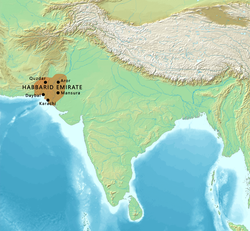
Back الإمارة الحبارية Arabic Habbarides French ہباری امارت PNB ھباري خاندان Sindhi ہباری امارت Urdu Habbari sulolasi Uzbek
Habbari Emirate هباري خاندان | |||||||||||
|---|---|---|---|---|---|---|---|---|---|---|---|
| 854–1011 | |||||||||||
 Map of the Habbarid Emirate circa 900 CE | |||||||||||
| Capital | Mansura | ||||||||||
| Common languages | Arabic Sindhi Multani | ||||||||||
| Religion | Sunni Islam | ||||||||||
| Government | Emirate | ||||||||||
| History | |||||||||||
• Habbari dynasty begins | 854 | ||||||||||
• Habbari dynasty ends | 1011 | ||||||||||
| |||||||||||
| Today part of | Sindh | ||||||||||
The Habbari (Arabic: اﻹﻣﺎرة اﻟﻬﺒﺎرﻳﺔ, Sindhi: هباري خاندان) were an Arab dynasty that ruled much of Greater Sindh, as a semi-independent emirate from 854 to 1024. Beginning with the rule of 'Umar bin Abdul Aziz al-Habbari in 854 CE, the region became semi-independent from the Abbasid Caliphate in 861, while continuing to nominally pledge allegiance to the Abbasid Caliph in Baghdad.[1][2] The Habbari ascension marked the end of a period of direct rule of Sindh by the Umayyad and Abbasid Caliphates, which had begun in 711 CE.
The Habbaris were based in the city of Mansura, and ruled central and southern Sindh south of Aror,[3] near the modern-day metropolis of Sukkur. The Habbaris ruled Sindh until they were defeated by Sultan Mahmud Ghaznavi in 1026, who then went on to destroy the old Habbari capital of Mansura, and annex the region to the Ghaznavid Empire, thereby ending Arab rule of Sindh.
- ^ P. M. ( Nagendra Kumar Singh), Muslim Kingship in India, Anmol Publications, 1999, ISBN 81-261-0436-8, ISBN 978-81-261-0436-9 pg 43-45.
- ^ P. M. ( Derryl N. Maclean), Religion and society in Arab Sindh, Published by Brill, 1989, ISBN 90-04-08551-3, ISBN 978-90-04-08551-0 pg 140-143.
- ^ A Gazetteer of the Province of Sindh. G. Bell and Sons. 1874.